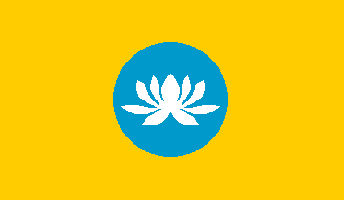 
KALMYKIA
The Kalmyks are of Mongolian origin. The Kalmyks' ancestors were western Mongols, the Oirots. The name Kalmyk comes probably from a Turkic term for Oirots who did not convert to Islam. In Russian official documents, the term Kalmyk appears since the end of the 16th c. The Kalmyks themselves started using it at the end of the 18th c. In the early 1600's, most of their ancestors (the Oirat) left their homeland, Dzhungaria, which is now part of Chinese-occupied East Turkestan, in hopes of settling in the rich pastures of the northern Caucasus Mountains. In 1771, the majority of the Oirat (approx. 125.000 Kalmyks) decided to move back to Dzhungaria in order to escape the Russian dictatorship and oppression, and to help the Oirots against the Chinese, but only a few survived the long journey. The Kalmyk Khanate was dissolved and its territory was incorporated into Astrakhan Province. Some of the remaining Kalmyks were resettled by the government along the Ural, Terek and Kuma rivers, some in Siberia. Various reforms introduced by authorities in 1825-1847 turned Kalmykia into an ordinary outlying colony of the Russian Empire. In 1892, serfdom was abolished in Kalmykia.
In 1943, the Kalmyks became as many other peoples of the USSR subject to deportations to Central Asia, Siberia, Altay, Kazakhstan. This relocation process lasted more than 13 years and its consequence was the death of more than 1/3 of the Kalmyks and the loss of many cultural features such as the language, religion, artefacts. Another factor which had contributed to the decline in the Kalmyk population (106,066 in 1959), was the suppression of the opposition against collectivization in the 1920s. In 1957-58, the autonomy was rehabilitated and a part of the Kalmyks returned to Kalmykia. The political, economic and psychological consequences of the deportation still weigh heavily on the Kalmyks. As a result, fierce animosity remains between the Russians and the Kalmyks.
An Institute for the revival of the Kalmyk language and Buddhism has been opened in Elista. In 1990, the Kalmyk Autonomous Soviet Socialist Republic proclaimed its sovereignty and in 1992 changed its name to the Republic of Kalmykia-Khalmg Tangch - used until Feb.96, at present Republic of Kalmykia. As the Republic changed its name, it approved federation within Russia under the condition that the mineral resources remain under local control. More than 10 political parties and social movements were active in Kalmykia in 1993.
What Are Their Lives Like?
After their return from Siberia, many Kalmyk were forced to conform to a dreary Soviet lifestyle. Today, many of them still live in the traditional gray, five-story apartment complexes of the 1950's. A number of Kalmyk in rural areas are herdsmen who raise cattle, sheep, goats, and a few camels. They are generally known for their love of fine horses and horse racing. Some Kalmyk are fishermen, especially those who live along the Volga River; others are farmers. Their principal crops include grains, corn, fodder grasses, mustard seed, sunflowers, and melons. Many Kalmyk have continued to live as pastoralists, and their lifestyle is one of seasonal migrations. Their dwellings are portable tents called gers or yurts, made of felt on lattice frames.
Marriage was formerly a symbol of adulthood among the Kalmyk. Marriages were ordinarily arranged by the parents, and a zurkhachi (astrologer) was consulted about the compatibility of a bride and groom. Couples were sometimes engaged as early as six years of age, and married between the ages of 16 and 18. Today, couples usually marry while they are in their early to mid-twenties. The Kalmyk traditionally lived in extended family units. Today, there is a growing tendency toward nuclear families. Sadly, divorce is becoming more common, and legal abortion is the principal means of birth control. The typical Kalmyk dress includes velvet hats, loose fitted coats, and heavily padded long pants. They often shave their heads, except for one small area in the back that is reserved for a pony-tail. Oral historic poetry is an important part of Kalmyk culture. It is traditionally recited by a poet, accompanied by a two-stringed lute called a dombr. Favorite pastimes include storytelling and singing. At social gatherings, the Kalmyk enjoy drinking kumiss (fermented mare's milk).
What Are Their Beliefs?
In the late 1500's, the Kalmyk adopted Tibetan Buddhism. Many were later forced to convert to Russian Orthodoxy. Today, most of the Kalmyk still celebrate traditional holidays. Kalmyk Buddhism is a mixture of ethnic beliefs and shamanism (belief in unseen gods, demons, and spirits). The people depend on shamans (medicine men) to cure the sick by magic and communicate with the gods. Despite laws forbidding shamanistic practices, the shamans have remained influential. The obo, a heap of stones thought to be inhabited by local spirits, often serves as a site for performing various rituals.
What Are Their Needs?
Decades of Soviet Communism have had a profound negative effect on the society, economy, environment, health, and culture of the Kalmyks. Medical facilities are inadequate. Limited water supply, poor hygiene, deficient diet, and alcoholism are all common problems. The Kalmyks have a high infant mortality rate, low life expectancy, and a persistence of diseases like tuberculosis. In 1989, 58 babies and dozens of adults who received blood transfusions were contaminated by AIDS. This was one of the worst cases of mass HIV contamination ever reported.
Population
Source: Norwegian Institute of International Affairs [NUPI] - Centre for Russian Studies
Photos: Valery Pavlov, www.bobiverson.com/kalmykia
     
© Copyright HUNMAGYAR.ORG
|







